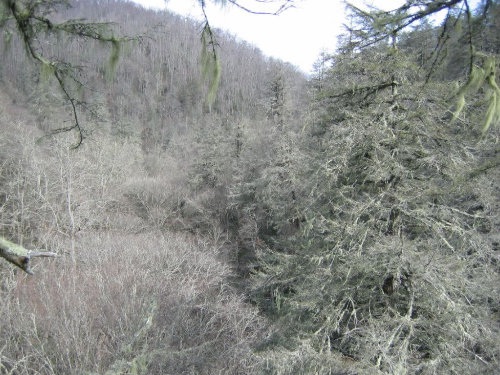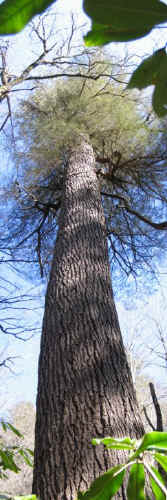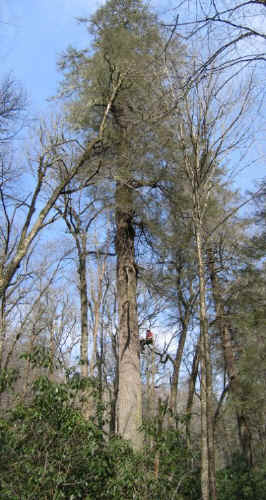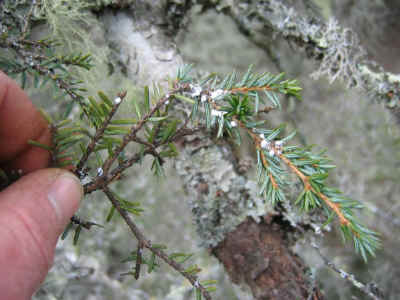Climb
of the Caldwell Colossus, March 7, 2006
Back in October 2002, Michael Davie and I accompanied a Tom
Horton, a writer
and Gary Braasch, a photographer deep into the heart of Upper
Caldwell Fork
in the Cataloochee District of GRSM. The topo maps indicated
excellent
habitat for big hemlocks, and my unofficial name for Cataloochee,
"Valley of
the Giants" was coined for good reason. They were doing a
story on
old-growth forests and big trees intended to be pitched to
Smithsonian
(unfortunately it was not accepted). We were on a hunt for big
hemlocks as
they had been the focus for many years of our respective tree
hunts due to
the pending arrival (at the time) of hemlock woolly adelgid (HWA).
In fact,
HWA was likely already there.

View of dying hemlocks. (yes it IS a color photo!)
Huge and ancient hemlocks characterize much of the forests of
the
predominantly acid-cove forests of Caldwell Fork except for the
upper
reaches which are either logged, rich cove, mesic oak or
northern hardwood
forests. Cataloochee is home to four white pines over 180' tall
(including
the Boogerman Pine) and the largest and tallest eastern hemlocks
documented
in the Smokies. In my old-growth surveys for the NPS in the
mid-nineties I
cored several hemlocks over 400 years old, and spotted a trail
cut hemlock
530 years old. Cataloochee is also home to the volume record Sag
Branch
Tuliptree, the tallest known white oak (147.3') and current or
former
National Champions of northern red oak, cinnamon clethra and a
recently
discovered mountain holly.
On the 2002 trip we spent three days hiking to and exploring the
tributaries
of Caldwell Fork and Big Bald Branch. Numerous huge hemlocks
were located
including two new hemlocks over 160' tall. In the dim light of
the last day
in the field we stumbled upon a massive hemlock over 16' in
girth and
lasered the height to 159.9' tall. Thoroughly impressed, we
vowed to return
and climb it. We named it the "Caldwell Colossus", a
name that would be well
justified later.

Caldwell Colossus view looking up
Mike and I knew for years this would be the largest hemlock in
the Smokies.
The record holder, the utterly huge Yonaguska Hemlock (~1402
ft3) had
recently died and a new record tree needed to be documented.
Access was the
problem- it was a five mile hike to the point we would need to
drop off the
trail and ascend the ~ one mile grueling rhododendron choked
stream. The
logistics of a three day extreme effort put a damper on our
enthusiasm for
the project.
However, the arrival of HWA sparked a renewed interest and sense
of urgency
to document the tree. So, on March 7th, 2006 Jess Riddle and I,
accompanied
by two NPS staff, ventured into the realm of the Caldwell
Colossus. We set
up camp the first day and prepared to bushwhack upstream to 1)
find a
realistic route and, 2) verify that the tree was still there. I
plugged in
estimated coordinates for the tree into my GPS unit and we set
forth.
Surprisingly, we encountered the tree a full 1/3 mile closer
than I had
remembered. We also found a route that would allow decent access
with the
climbing gear.

Will on trunk
The next day I set a rope and climbed the tree to obtain volume
measurements
and perform a tape drop to confirm the height (taped to 159.7'-
0.2 feet off
of the laser height of 159.9'). Jess was busy with vegetation
plots
surrounding the tree for the "Tsuga Search" project.
The two NPS folks were
on a soil treatment blitz, treating over 3000 diameter inches of
hemlocks
surrounding and including the Colossus.

Infested new growth at 155'
The general consensus was that the HWA impact in the area was
the worst any
of us had seen in the Smokies. The view from the emergent top
was crushing.
Virtually every tree was stone gray, defoliated or dead
(remember, this was
in less than four years). The Colossus had about one square foot
of green
growth which was entirely reinfested with HWA. I think the tree
is dead, but
it was treated anyway in the hopes that it has yet to reflush a
new crown. I
have been impressed with the recovery of urban hemlocks from
almost complete
defoliation, but the old-growth specimens may be different. I
hope not!
The volume calculations based on the climb data indicated a wood
volume of
1385 ft3. This is the largest single trunked specimen known of
the species
and currently the largest hemlock in the Smokies. The closest
contender is
the Long Branch Hemlock in the Greenbrier District that scaled
1294 cubic
feet in a climb last year. Unfortunately, the Colossus contained
a trunk
reiteration that I did not measure. It should be included in the
total trunk
volume to be consistent with the other trees but somehow I
passed it on the
way down. However, it would only contain 8-10 cubic feet at
most.

Jesse Webster (left) and Mike Zumwalt (right) preparing to soil drench the Colossus
The next day we scouted for new big and tall trees and were
richly rewarded.
We found two new trees over 160' and one over 165'. Several will
scale over
1000 cubic feet and one scaled ~1200 cubes based on macroscope
measurements.
The first day Mike Zumwalt and I located a huge red maple
(16'6" X 123.9' X
56'= NC state champion) and an immense fallen hemlock that would
have
closely challenged the Colossus in wood volume. We reconstructed
the trunk
and determined that at 100 feet up it was 10'1" in girth-
larger than any
other GRSM hemlock measured (the Colossus was "only"
8'5" at 100' up). With
a cbh of 15'10" and slow taper, this tree likely exceeded
1300 ft3.
One tree Mike Davie and I found on the previous trip that we
named the
"Triceratops Tree" eluded rediscovery. I think the
tree has fallen, but if
not will hold promise to be one of the largest since it has a
thick, tall
trunk and three large leaders composing a huge crown. However,
standing or
not it is likely dead from HWA. We did spot two green trees that
defy all
logic since the surrounding trees are defoliated.

Green Tree among the dead
I wish to thank the National Park Service for their support of
this climb
and the treatments of these magnificent trees. Extreme gratitude
goes to Tom
Remaley and Kristine Johnson of the Vegetation Management
Division of the
Great Smoky Mountains National Park. Their enthusiasm and
support of ENTS
and the Tsuga Search is phenomenal. The dedication of the
assisting NPS HWA
employees, Jesse Webster and Mike Zumwalt was evident in their
persistence
in the rugged terrain of the treatment zone and exhaustive site
access we
did over and over. They all are actively assisting ENTS in
leaving a living
legacy of the great Smoky Mountain hemlock forests for the
future. In my
eyes, you all can't be thanked enough.
Will Blozan
|